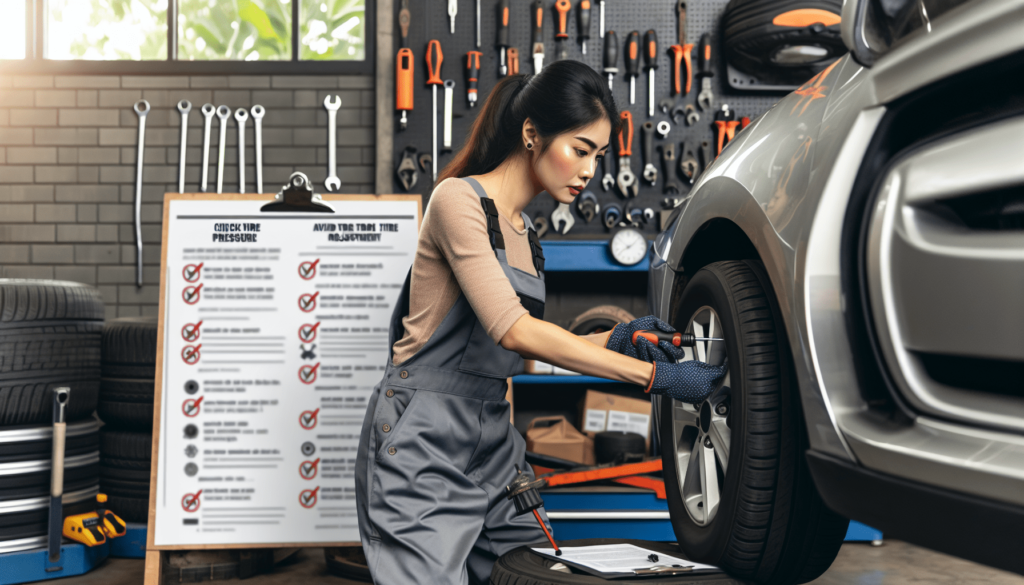Are you tired of having to constantly get your wheel alignment adjusted? It can be frustrating and costly to keep going back to the mechanic for this issue. In this article, we will explore some helpful tips and techniques to help you avoid frequent wheel alignment adjustments. By following these recommendations, you can save time, money, and ensure that your vehicle’s wheels stay properly aligned for longer periods of time. So let’s get started on keeping your wheels in check and your driving experience smooth and comfortable.
Choose High-Quality Tires
Opt for reputable tire brands
When it comes to choosing tires for your vehicle, it’s crucial to opt for reputable tire brands. High-quality tires offer better performance, durability, and safety on the road. Reputable brands have a proven track record of manufacturing reliable tires that are designed to withstand various road conditions and provide excellent traction. Doing some research and reading customer reviews can help you identify the best tire brands that suit your specific needs and vehicle.
Ensure proper tire inflation
Proper tire inflation is essential for optimal performance and safety. It not only extends the life of your tires but also improves fuel efficiency. Underinflated tires can lead to increased fuel consumption, poor handling, and uneven tire wear. On the other hand, overinflated tires can result in a harsh ride and reduced traction. To ensure proper tire inflation, refer to your vehicle’s owner’s manual or the placard located on the driver’s door jamb for recommended tire pressure. Regularly check your tire pressure and inflate or deflate them as needed.
Rotate tires regularly
Rotating your tires regularly is another crucial factor in maintaining their longevity. Front and rear tires wear differently due to various factors, such as weight distribution and steering dynamics. By rotating your tires at regular intervals, you can ensure even wear and extend their lifespan. The general recommendation is to rotate your tires every 6,000 to 8,000 miles or as advised by your vehicle’s manufacturer. Regular tire rotations not only promote even wear but also contribute to better handling and traction.
Drive Smoothly
Avoid potholes and rough surfaces
Driving smoothly and avoiding potholes and rough surfaces can help preserve the health of your tires and suspension system. Potholes and rough surfaces can cause damage to your tires, wheels, and suspension components. They can lead to punctures, sidewall damage, and misalignments. By staying vigilant and avoiding such obstacles, you can minimize the risk of tire and suspension damage. If you cannot avoid a pothole, try to slow down and go over it carefully.
Take it easy on speed bumps
Speed bumps can be quite harsh on your vehicle’s suspension. Driving over them at high speeds or without slowing down can lead to an uncomfortable ride and potential damage to your suspension components. To protect your tires and suspension system, it’s important to take it easy on speed bumps. Slow down and approach speed bumps at an appropriate speed to minimize the impact on your vehicle.
Steer clear of curbs
Curbs may seem harmless, but they can cause damage to your tires, wheels, and even the alignment of your vehicle. Avoid hitting curbs whenever possible, as the impact can lead to tire sidewall damage, wheel rim bends, and misalignment. Be cautious when parking and maneuvering your vehicle, especially in tight spaces. Taking the time to steer clear of curbs can prevent costly repairs and preserve the longevity of your tires.

Check Suspension System
Inspect shocks and struts
Regularly inspecting your vehicle’s shocks and struts is crucial for maintaining a smooth and comfortable ride. Worn-out or damaged shocks and struts can affect your vehicle’s handling, stability, and tire wear. Signs of worn-out shocks and struts include excessive bouncing, nose-diving during braking, and uneven tire wear. If you notice any of these signs, it’s important to have your suspension system inspected by a professional and replace any worn-out components.
Check for worn-out bushings
Bushings are small, rubber-like components that provide cushioning and support in various parts of your vehicle’s suspension system. Over time, these bushings can wear out due to constant movement and exposure to the elements. Worn-out bushings can cause excessive vibrations, noise, and poor handling. Regularly checking for signs of worn-out bushings and replacing them as needed can help maintain the integrity of your suspension system and promote a smoother ride.
Look for signs of sagging
Sagging suspension can indicate worn-out or damaged components that need attention. Excessive weight, regular towing, and aging can contribute to sagging suspension. Signs of sagging include a visibly lower ride height, poor handling, and uneven tire wear. If you notice any signs of sagging, it’s important to have your suspension system inspected by a professional. Replacing worn-out components and addressing any underlying issues can restore the proper ride height and improve the performance of your vehicle.
Maintain Proper Wheel Balance
Regularly balance tires
Maintaining proper wheel balance is essential for a smooth and comfortable ride. Over time, the distribution of weight on your tires can become uneven, leading to vibrations and uneven tire wear. Regularly balancing your tires can help ensure that weight is distributed evenly, minimizing vibrations and promoting better tire performance. It’s recommended to have your tires balanced every 6,000 to 8,000 miles or as advised by your tire manufacturer or service provider.
Check for uneven tire wear
Uneven tire wear can indicate an imbalance in your wheels and suspension system. Inspecting your tires for signs of uneven wear, such as tread wear on one side or in the center, can help you identify potential balance issues. If you notice uneven tire wear, it’s important to have your tires balanced and your suspension system checked. Addressing any imbalance promptly can prevent further tire damage and provide a smoother driving experience.
Address vibrations promptly
Vibrations while driving can be a sign of wheel balance issues or other underlying problems with your vehicle. If you experience vibrations, especially at higher speeds, it’s important to address them promptly. Ignoring vibrations can lead to increased tire wear, decreased fuel efficiency, and potential damage to other components. Have your wheels balanced and your suspension system inspected to identify and resolve any issues that may be causing the vibrations.

Keep Alignment in Check
Get alignment checked regularly
Regularly checking your vehicle’s alignment is crucial for maintaining proper tire wear and handling. Over time, your vehicle’s alignment can gradually shift due to various factors, such as normal wear and tear, potholes, or hitting curbs. It’s recommended to have your alignment checked at least once a year or if you notice any signs of misalignment, such as the vehicle pulling to one side, uneven tire wear, or a steering wheel that is off-center. Professional alignment services can ensure that the wheels are correctly aligned, promoting better tire performance and extending their lifespan.
Address alignment issues promptly
Addressing alignment issues promptly is essential for maintaining the health of your tires and overall vehicle performance. Ignoring misalignment can result in uneven tire wear, decreased fuel efficiency, and poor handling. If you suspect misalignment, have your alignment checked and corrected by a professional. Proper alignment ensures that all four wheels are properly aligned with each other and the vehicle’s specifications, promoting optimal handling and tire longevity.
Check for signs of misalignment
In addition to regular alignment checks, it’s important to be mindful of signs that may indicate misalignment. These signs include uneven tire wear, a steering wheel that is off-center when driving straight, the vehicle pulling to one side, or a vibrating steering wheel. If you notice any of these signs, it’s crucial to have your alignment checked and corrected. By addressing misalignment promptly, you can prevent further tire wear and ensure the safety and stability of your vehicle.
Avoid Overloading
Stay within load capacity limits
Overloading your vehicle can have adverse effects on its performance and safety. Each vehicle has specific load capacity limits that should not be exceeded. These limits are defined by the manufacturer and can be found in your vehicle’s owner’s manual or on the door jamb placard. It’s essential to stay within these limits to prevent excessive strain on your tires, suspension, and other crucial components. Overloading can lead to decreased fuel efficiency, increased tire wear, and compromised handling.
Distribute weight evenly
When carrying a heavy load, it’s important to distribute the weight evenly throughout your vehicle. Uneven weight distribution can lead to imbalances and put excessive strain on specific areas, such as the tires and suspension. To ensure proper weight distribution, place the heaviest items in the center of your vehicle and distribute the remaining weight evenly. This helps maintain stability, reduces the risk of tire and suspension damage, and promotes better overall vehicle performance.
Consider using a rooftop carrier for extra cargo
If you frequently need to carry extra cargo or luggage, consider using a rooftop carrier. Rooftop carriers are designed to safely and effectively transport additional items without overloading your vehicle’s interior or compromising its weight distribution. However, it’s important to follow manufacturer guidelines for the rooftop carrier’s load capacity and secure the cargo properly. By utilizing a rooftop carrier, you can avoid overloading your vehicle’s interior and ensure that weight is distributed evenly.

Steer Clear of Potentially Damaging Driving Habits
Avoid harsh braking
Harsh braking can put excessive strain on your tires, suspension, and braking system. It can cause premature tire wear, brake pad damage, and even lead to accidents. To avoid these issues, practice smooth and gradual braking. Allow enough time and distance to come to a complete stop without needing to slam on your brakes. By avoiding harsh braking, you can extend the life of your tires, preserve your suspension system, and ensure safe and smooth stops.
Minimize aggressive cornering
Aggressive cornering, such as taking corners at high speeds or with excessive force, can cause unnecessary stress on your tires and suspension. It can lead to tire sidewall damage, uneven tire wear, and compromised handling. To minimize these risks, approach corners with caution and maintain a safe speed. Gradually accelerate out of the corner and avoid sudden steering inputs. By practicing smooth and controlled cornering, you can protect your tires, suspension, and maintain better overall vehicle control.
Don’t ignore warning signs
Your vehicle is equipped with warning signs, such as dashboard lights or unusual noises, to alert you of potential issues. It’s important not to ignore these warning signs and address them promptly. Whether it’s an illuminated tire pressure warning light or an unusual noise coming from your suspension, ignoring such signs can lead to further damage or unsafe driving conditions. Take any warning signs seriously and have your vehicle inspected by a professional to diagnose and resolve any underlying issues.
Regularly Inspect Steering System
Check power steering fluid levels
Regularly checking your vehicle’s power steering fluid levels is essential for maintaining proper steering functionality. Low power steering fluid levels can result in reduced steering response, increased effort to turn the wheel, and potential damage to the power steering system. Refer to your vehicle’s owner’s manual for the correct procedure to check and add power steering fluid as needed. By ensuring adequate fluid levels, you can maintain smooth and precise steering control.
Look for leaks or damage
Inspecting your vehicle’s steering system for leaks or damage is crucial for early detection and prevention of potential issues. Leaks or damage to components, such as the power steering rack or hoses, can lead to steering system failure or fluid loss. Regularly inspect your steering system for any signs of leaks, such as fluid puddles, or visible damage, such as cracks or leaks in hoses. If you notice any leaks or damage, have your vehicle inspected by a professional to prevent further damage and maintain optimal steering performance.
Ensure proper belt tension
The steering system in many vehicles relies on belts to transfer power and control the movement of various components. Over time, these belts can become loose or worn, affecting the performance of the steering system. Regularly inspecting your vehicle’s belts and ensuring proper tension is crucial for maintaining smooth and responsive steering. If you notice any signs of loose or worn belts, such as squealing noises or visible damage, have them inspected or replaced by a professional to ensure proper belt tension and optimal steering performance.

Be Mindful of Road Conditions
Slow down on uneven roads
Uneven roads can pose a challenge to your vehicle’s suspension system and tires. To protect your vehicle and ensure a comfortable ride, it’s important to slow down on uneven roads. Reduce your speed and take it easy when driving over rough surfaces, potholes, or uneven pavement. By doing so, you can minimize the impact on your suspension, preserve your tires, and maintain better control of your vehicle.
Avoid driving through construction zones
Construction zones often have uneven surfaces, debris, and potential hazards that can damage your tires or suspension system. Whenever possible, avoid driving through construction zones. If you cannot avoid them, reduce your speed and drive cautiously. Keep an eye out for potential obstacles or debris that may cause damage. By being mindful of construction zones and taking necessary precautions, you can minimize the risk of tire and suspension damage.
Navigate carefully on gravel or dirt roads
Gravel or dirt roads can be challenging to navigate, especially for your tires and suspension system. These surfaces often have loose gravel, potholes, or ruts that can cause damage if not approached carefully. When driving on gravel or dirt roads, reduce your speed and maintain a steady pace. Avoid sudden braking or accelerating, as it can result in loss of traction and potential tire or suspension damage. By navigating carefully on these surfaces, you can protect your tires and suspension system from unnecessary wear and tear.
Follow Manufacturer’s Guidelines
Adhere to recommended maintenance schedule
Following the manufacturer’s recommended maintenance schedule is essential for keeping your vehicle in optimal condition. This includes regular inspections, oil changes, filter replacements, and other essential maintenance tasks. It’s important to consult your vehicle’s owner’s manual for the recommended schedule and adhere to it. By following the maintenance schedule, you can ensure that your vehicle operates efficiently, extends its lifespan, and minimizes the risk of potential tire or suspension issues.
Use appropriate tire specifications
Each vehicle has specific tire specifications recommended by the manufacturer. These specifications include tire size, load index, speed rating, and other essential details. It’s crucial to use tires that meet these specifications to ensure proper fitment and performance. Using tires that do not meet the manufacturer’s specifications can lead to compromised handling, potential tire damage, and even voiding the warranty. When purchasing new tires, consult your vehicle’s owner’s manual or seek professional advice to ensure the tires meet the appropriate specifications.
Follow guidelines for towing or hauling loads
If you need to tow or haul loads with your vehicle, it’s important to follow the manufacturer’s guidelines and recommendations. Each vehicle has specific towing and hauling capacities that should not be exceeded. Exceeding these limits can put excessive strain on your tires, suspension system, and other crucial components. Before towing or hauling, consult your vehicle’s owner’s manual for the recommended towing capacity, tongue weight, and other important details. By following these guidelines, you can safely tow or haul loads without causing damage to your vehicle.


